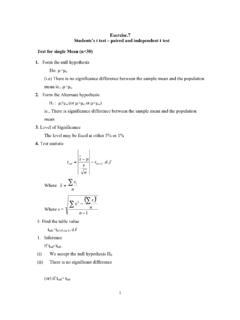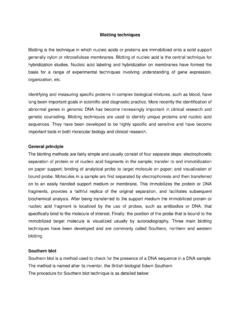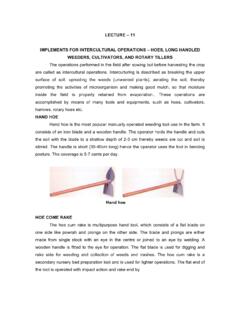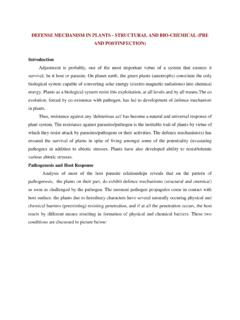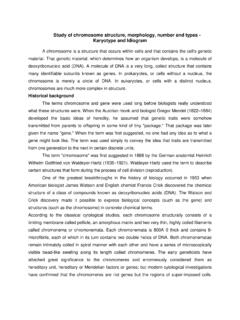Transcription of AGRO-CLIMATIC ZONES OF INDIA AND ANDHRA …
1 AGRO-CLIMATIC ZONES OF INDIA AND ANDHRA PRADESH Planning Commission has demarcated the geographical area of INDIA into 15 AGRO-CLIMATIC regions. These are: 1. Western Himalayan Region: Jammu and Kashmir, Himachal Pradesh, Uttar Pradesh, Uttaranchal. The region consists of skeletal soils of cold region, podsolic soil, mountainous soil, hilly brown soil. Lands have steep slopes in undulating terrain. 2. Eastern Himalayan Region: Assam Sikkim, West Bengal and all North-Eastern states. These region falls under high rainfall and high forest cover. Shifting cultivation is practiced in nearly one third of the cultivated area and this causes degradation of the soil, with heavy runoff, soil erosion and flood. 3. Lower Gangetic Plains Region: West Bengal, soils are mostly alluvial and are prone to floods. 4. Middle Gangetic Plains Region: Uttar Pradesh, Bihar.
2 About 39 percent of the gross cropped area of this region is irrigated. 5. Upper Gangetic Plains Region: Uttar Pradesh. Irrigation is trough canals and tube wells. A good potential for exploitation of ground water. 6. Trans-Gangetic Plains Region: Punjab, Haryana, Delhi and Rajasthan. These regions have the highest sown areas, highest irrigated area, high cropping intensity and high ground water utilization. 7. Eastern Plateau and Hills Region: Maharashtra, Uttar Pradesh, Orissa and West Bengal. Irrigation is through canals and tanks. The soils are shallow and medium in depth. 8. Central Plateau and Hills Region: Madhya Pradesh, Rajasthan, Uttar Pradesh. 9. Western Plateau and Hills Region: Maharashtra, Madhya Pradesh and Rajasthan. The average rainfall of this zone is 904 mm. 10. Southern Plateau and Hills Region: ANDHRA Pradesh, Karnataka, Tamil Nadu.
3 Dry farming is adopted and the cropping intensity is 111 percent. 11. East Coast Plains and Hills Region: Orissa, ANDHRA Pradesh, Tamil Nadu and Pondicherry. Irrigation is through canals and tanks. 12. West Coast Plains and Ghats Region: Tamil Nadu, Kerala, Goa, Karnataka, Maharashtra. Variety of cropping pattern, rainfall and soil types. 13. Gujarat Plains and Hills Region: Gujarat. This zone is arid with low rainfall in most parts. Irrigated through tube wells and wells. 14. Western Dry Region: Rajasthan. Hot sandy desert, erratic rainfall, high evaporation, scanty vegetation. The ground water is often deep and often brackish. Famine and drought are common features of this region. 15. The Islands Region: Andaman and Nicobar Islands, Lakshadweep. These regions are typical equatorial with rainfall of 3000 mm spread over eight to nine months.
4 Largely forest zone with undulated land. agro climatic ZONES of ANDHRA Pradesh The cropped area in ANDHRA Pradesh is divided into seven ZONES based on the AGRO-CLIMATIC conditions. The classification mainly concentrates on the range of rainfall received, type and topography of the soils. 1. Krishna Godavari Zone: It covers East Godavari Part, West Godavari, Krishna, Guntur, and contiguous areas of Khammam, Nalgonda and Prakasam. Rainfall of this zone is 800-1100mm. Soil type is deltaic alluvium, red soils with clay, red loams, coastal sands and saline soils. Paddy, Groundnut, Jowar, Bajra, Tobacco, cotton, chillies, Sugarcane and Horticultural Crops are the important crops grown. 2. North Coastal ZONES : Covers Srikakulam, Vizianagaram, Visakhapatnam and uplands of East Godavari districts. This zone receives a rainfall of 1000-1100 mm mainly from south west monsoon.
5 Soil type is red soils with clay base, pockets of acidic soils, laterite soils, Soils with PH 4-5. Main crops grown in these ZONES are Paddy, Groundnut, Jowar, Bajra, Mesta, Jute, Sun hemp, Sesame, Black gram and Horticultural Crops. 3. Southern Zone: Districts in this zone are Nellore, Chittoor, Southern parts of Prakasam and Cuddapah and Eastern parts of Anantapur. Rainfall received is about 700-1100 mm. Soil type is Red loamy soils, Shallow to moderately deep. Crops like Paddy, Groundnut,cotton Sugarcane. Millets and Horticultural Crops are mainly grown. 4. North Telangana Zone: Adilabad, Karimnagar, Nizamabad, Medak (Northern part), Warangal (Except ), Eastern tips of Nalgonda and Khammam are the districts in this zone. Rainfall received is about 900-1500 mm. Soil type is Chalkas, Red sandy soils, Dubbas, Deep Red loamy soils, Very deep black cotton soils.
6 Paddy,Sugarcane,Castor,Jowar, Maize, Sunflower, Tuemeric, Pulses and Chillies are the important crops. 5. Southern Telangana Zone: Hyderabad, Rangareddy, Mahabubnagar (except southern border), Nalgonda (except North eastern border), Medak (Southern parts), Warangal (North Western Part) are the districts covered. This zone receives a rainfall of about 700-900 mm. Soil type is red earth with loamy sub soil (Chalkas). Paddy, Sunflower, Safflower, Grapevine, Sorghum, Millets, Pulses and Orchard crops are the important crops. 6. Scarce rainfall zone: the districts covered are Kurnool, Anantapur, Prakasam (western parts), Cuddapah (Northern part), Mahabubnagar (Southern border). Receives a rainfall of 500-750 mm. Soil type is red earths with loamy soils (Chalkas), red sandy soils and black cotton soils in pockets. Cotton,Korra,Sorghum,Millets, Groundnut, Pulses, Paddy are the important crops.
7 7. High altitude and Tribal areas: Northern borders of Srikakulam, Vizianagaram and Visakhapatnam, East Godavari and Khammam are the districts covered. This zone receives a rainfall more than 1400 mm. Horticultural Crops, Millets, Pulses Chillies, Turmeric and Pepper are the important crops grown.


